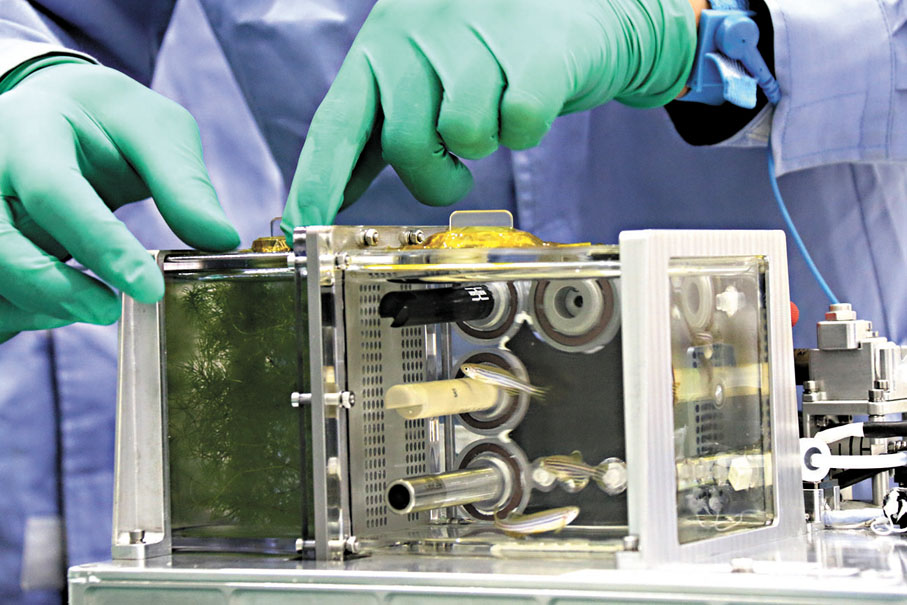【News Buddy】神十八「魚航員」狀態良好

【原文】摘錄自5月20日香港《文匯報》:5月19日舉行的2024年度「天地共播一粒種——青少年與航天員一起養斑馬魚」科學教育活動上,科學家們介紹了隨神舟十八號飛船進入太空站的「航天魚」最近情況。
中國科學院空間應用工程與技術中心研究員倉懷興表示,太空站小型受控生命生態實驗組件自4月26日由航天員轉移至問天艙生命生態實驗櫃並開展實驗以來,已在軌穩定運行了24天,4條斑馬魚目前狀態良好。他還透露了太空站未來的「動物成員」,小鼠以及果蠅將在後續任務中進入太空站。
「天地共播一粒種——青少年與航天員一起養斑馬魚」活動旨在充分發揮太空站科技資源優勢,為青少年搭建科學探究、科學實踐平台,在青少年心中種下科學的「種子」,激勵廣大青少年追尋「科學夢」「航天夢」。本次活動由中國科學院學部工作局、教育部基礎教育司主辦,中國科學院空間應用工程與技術中心承辦,教育部基礎教育司副司長李海勝、中國科學院學部工作局三級職員周德進出席啟動儀式並致辭。
在啟動儀式上,中國科學院水生生物研究所研究員王高鴻介紹,斑馬魚是一種模式生物,經測定其基因組約有87%跟人類一樣,相似程度較高,在藥物研發等領域都有很好的作用。航天員長期在太空飛行會面臨骨質疏鬆、肌肉萎縮等情況,斑馬魚在這方面是非常好的研究模式,無論是在地面還是太空中都具有很高的研究價值。
「太空魚缸」太空站小型受控生命生態實驗組件自4月26日由航天員轉移至問天艙生命生態實驗櫃並開展實驗以來,已在軌穩定運行了24天,4條斑馬魚目前狀態良好。
王高鴻表示,目前航天員成功開展了兩次水樣採集和一次魚食盒更換操作,發現了斑馬魚在微重力下表現出腹背顛倒游泳、旋轉運動、轉圈等定向行為異常現象。後續,科學家將利用返回的回收水樣、魚卵等樣品,結合斑馬魚太空運動行為視頻等,開展太空環境對脊椎動物生長發育與行為的影響研究,同時為太空密閉生態系統物質循環研究提供支撐。
科學家們希望,下一步能在太空利用斑馬魚魚卵培養小魚,從小魚到成魚,從成魚再到產卵,真正實現水生生物在太空的全生命周期培養。
從擬南芥到斑馬魚,中國太空站生命科學領域的實驗已從植物發展到動物。中國科學院空間應用工程與技術中心研究員倉懷興表示,後續的實驗將更加精彩,也會愈來愈有意思。未來,科學家們期待將四隻兩雌兩雄小鼠以及果蠅們送往太空站。在太空站,小鼠除可以進行生理性的研究外,還可以將牠們在太空中的活動記錄下來,進行行為心理認知方面的研究,進一步探究腦神經科學等領域問題。
Shenzhou 18 "Space Fish" is in good condition
【譯文】On May 19, in "Sowing a Seed Together - Youth and Astronauts Raising Zebrafish Together" science education activity, scientists introduced the recent situation of the "space fish" that went to the space station with the Shenzhou-18 spacecraft.
Cang Huaixing, a researcher at the Center for Space Application Engineering and Technology of the Chinese Academy of Sciences, said that the small controlled life-ecology experiment module of the space station has been operating stably in orbit for 24 days since the astronauts transferred it to the Life-ecology Experiment Cabinet of the space capsule on April 26 and started the experiments. The four zebrafish eggs are in good condition now. He also revealed the future "animal members" of the space station, mice and fruit flies, which will enter the station in the following missions.
The "Sowing a Seed Together - Youth and Astronauts Raising Zebrafish Together "activity aims to fully utilize the advantages of the space station's scientific and technological resources to build a platform for youth to explore and practice science, to plant seeds of science in their hearts, and to motivate them to pursue their "scientific dream" and "space dream". The activity was organized by the Bureau of Academic Departments of the Chinese Academy of Sciences (CAS) and the Department of Basic Education of the Ministry of Education and hosted by the Center for Space Application Engineering and Technology of the CAS . Li Haisheng, deputy director of the Department of Basic Education of the Ministry of Education, and Zhou Dejin, a third-grade staff member of the Bureau of Academic Departments of the Chinese Academy of Sciences, attended the kick-off ceremony and delivered speeches.
At the launching ceremony, Mr. Wang Gaohong, a researcher from the Institute of Aquatic Biology of the CAS, introduced that the zebrafish is a model organism. It has been determined that about 87% of its genome is the same as that of human beings, which is a high degree of similarity and beneficial in drug research and development. The zebrafish is a model organism for astronauts who face osteoporosis and muscle atrophy during long-term space flights, and it is a perfect research model for astronauts both on the ground and in space. The "Space Fishbowl", space station's small controlled life ecology experiment module has been running stably in orbit for 24 days since April 26, when astronauts transferred it to the life ecology experiment cabinet of the space capsule to carry out experiments, and the four zebrafish eggs are in good condition now.
Wang Gaohong said that the astronauts have managed to collect water samples twice and have replaced the fish food box once. They found that the zebrafish were showing directional behavior anomalies, such as inverted swimming and rotary movement, in the microgravity environment on Tiangong. In the future, scientists will make use of the recovered water samples, fish eggs and other samples returned, combined with the video of zebrafish's movement behaviour in space, to research the impact of the space environment on the growth and development of vertebrate animals and their behaviour, and at the same time provide support for the research on the material cycle of space confined ecosystems. Scientists hope the next step will be using zebrafish eggs in space to cultivate small fish, from small fish to adult fish, and from adult fish to spawning, genuinely realizing the entire life cycle of aquatic organisms in space culture.
From mouse-ear cress to zebrafish, experiments in the field of life sciences on the Chinese space station have developed from plants to animals. Cang Huaixing, a researcher at the Center for Space Application Engineering and Technology Center of the Chinese Academy of Sciences, said that subsequent experiments will be even more exciting and enjoyable. In the future, scientists are looking forward to sending four mice, two females and two males, and fruit flies to the space station. At the space station, the mice will be able to carry out physiological research, record their activities in space for behavioural and psycho-cognitive research, and further investigate issues in the field of brain neuroscience.
◆ 琬琰
